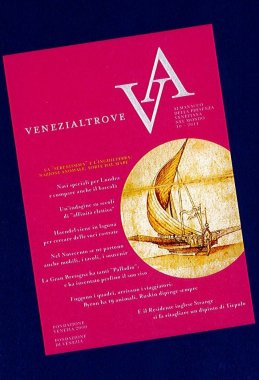For ten years, “VeneziAltrove, Almanacco della presenza italiana nel mondo” recounted how the achievements of art and culture produced for centuries in laguna has left the city. The idea was by Giuseppe De Rita, then President of Fondazione Venezia 2000 that continued to achieve it over the years, in collaboration with the Fondazione di Venezia. Until last year, VeneziAltrove was published by Marsilio, but from this year, is also available online.
Thanks to Augusto Gentili (faithful collaborator as other scholars, including Irene Favaretto, Stephanie Mason, Marino Zorzi, Linda Borean, Gino Benzoni and, for music, Sandro Cappelletto), VeneziAltrove came to a solution of a mystery of art: give a name to the Thyssen Knight by Vittore Carpaccio; it discovered a Titian already Barbarigo, believed lost after the sale in Russia, and another who was forgotten in a bath to London; it published the first important correspondence. Today, VeneziAltrove is a reference to the scholars, but also to the public who believes in curiosity: the most effective search engine, Google, lists 6,440 sites that mention the name; for just one example, the latest issue of the prestigious Burlington Magazine takes as a source in a study tizianesco, Antonio Mazzotta.
The Almanac has rediscovered musicians Venetians, their time celebrated but now forgotten (as Giovanni Antonio Rigatti, who lived in the first half of the seventeenth century); it narrated how they passed in laguna, before ending up in London, 90 paintings and sculptures of 200 Gonzaga; it launched the idea of an 'index of backgrounds' of Venetian paintings. Over the past five years, VeneziAltrove has monographic form, investigating the relationship between Serenissima and other major capital cities, or countries: after St. Petersburg, Istanbul, Vienna and Eastern Europe, this issue is devoted to London. The British, who have almost 'revered' Palladium, they even 'stolen' his face; there is a portrait of course, and the traditional ones are the result of a British forgery, as Guido Beltramini clarifies; the spies did arrive in Venice the love letters of Queen Elizabeth (means the first) to a French nobleman; British residents were the focus of art trades, and one of them is even 'crop' a painting by Tiepolo, tells Rosella Lauber, a canvas with a pigeon, which he liked so much; and Handel comes into the lagoon looking for castrated singers. Between streets and canals, the British do not aim only to great masterpieces, but blending even the furnishings: between the 19th and 20th centuries, in fact, an infinite number of 'legal' chests, drawers and chairs, as well as means, 'souvenirs' that already then went out of fashion.

